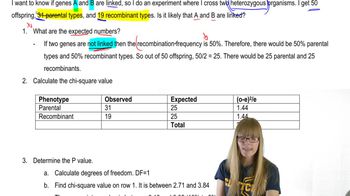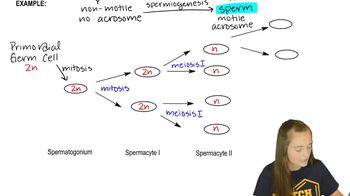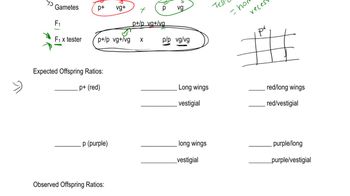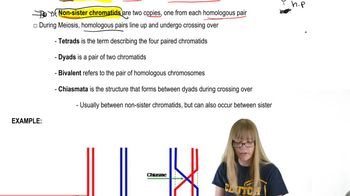Table of contents
- 1. Introduction to Genetics51m
- 2. Mendel's Laws of Inheritance3h 37m
- 3. Extensions to Mendelian Inheritance2h 41m
- 4. Genetic Mapping and Linkage2h 28m
- 5. Genetics of Bacteria and Viruses1h 21m
- 6. Chromosomal Variation1h 48m
- 7. DNA and Chromosome Structure56m
- 8. DNA Replication1h 10m
- 9. Mitosis and Meiosis1h 34m
- 10. Transcription1h 0m
- 11. Translation58m
- 12. Gene Regulation in Prokaryotes1h 19m
- 13. Gene Regulation in Eukaryotes44m
- 14. Genetic Control of Development44m
- 15. Genomes and Genomics1h 50m
- 16. Transposable Elements47m
- 17. Mutation, Repair, and Recombination1h 6m
- 18. Molecular Genetic Tools19m
- 19. Cancer Genetics29m
- 20. Quantitative Genetics1h 26m
- 21. Population Genetics50m
- 22. Evolutionary Genetics29m
4. Genetic Mapping and Linkage
Crossing Over and Recombinants
Problem 4a
Textbook Question
Genes E and H are syntenic in an experimental organism with the genotype EH/eh. Assume that during each meiosis, one crossover occurs between these genes. No homologous chromosomes escape crossover, and none undergo double crossover. Are genes E and H genetically linked? Why or why not? What is the proportion of parental gametes produced by meiosis?
 Verified step by step guidance
Verified step by step guidance1
span>1. Understand the concept of synteny: Genes E and H are located on the same chromosome, which means they are syntenic. This is a key factor in determining genetic linkage.</span
span>2. Define genetic linkage: Genes are considered genetically linked if they are located close to each other on the same chromosome and tend to be inherited together because they do not assort independently.</span
span>3. Analyze the crossover scenario: Since one crossover occurs between genes E and H during each meiosis, this will affect the linkage. A crossover event can separate linked genes, leading to recombinant gametes.</span
span>4. Determine the proportion of parental gametes: In this scenario, since one crossover occurs, half of the gametes will be parental (EH and eh) and half will be recombinant (Eh and eH). This is because each crossover event results in two parental and two recombinant chromatids.</span
span>5. Conclude on genetic linkage: Despite being syntenic, genes E and H are not genetically linked in this scenario because the crossover ensures that parental and recombinant gametes are produced in equal proportions.</span
Recommended similar problem, with video answer:
 Verified Solution
Verified SolutionThis video solution was recommended by our tutors as helpful for the problem above
Video duration:
1mPlay a video:
Was this helpful?
Key Concepts
Here are the essential concepts you must grasp in order to answer the question correctly.
Genetic Linkage
Genetic linkage refers to the tendency of genes located close to each other on the same chromosome to be inherited together during meiosis. When genes are syntenic, they are physically located on the same chromosome, which can lead to a lower frequency of recombination between them. If genes E and H are genetically linked, they will produce more parental gametes than recombinant gametes due to their proximity.
Recommended video:
Guided course

Chi Square and Linkage
Crossover and Recombination
Crossover is a process during meiosis where homologous chromosomes exchange segments of genetic material, leading to genetic recombination. In this scenario, with one crossover occurring between genes E and H, the resulting gametes will include both parental types and recombinant types. The frequency of these types depends on the distance between the genes; closer genes result in fewer recombinant gametes.
Recommended video:
Guided course

Recombination after Single Strand Breaks
Parental and Recombinant Gametes
Parental gametes are those that contain the original combinations of alleles from the parents, while recombinant gametes have new combinations due to crossover events. In the case of the genotype EH/eh, if one crossover occurs between E and H, the expected ratio of parental to recombinant gametes can be calculated. This ratio helps determine the genetic linkage and the degree of recombination between the genes.
Recommended video:
Guided course

Gamete Development

 7:52m
7:52mWatch next
Master Gamete Genotypes with a bite sized video explanation from Kylia Goodner
Start learning




